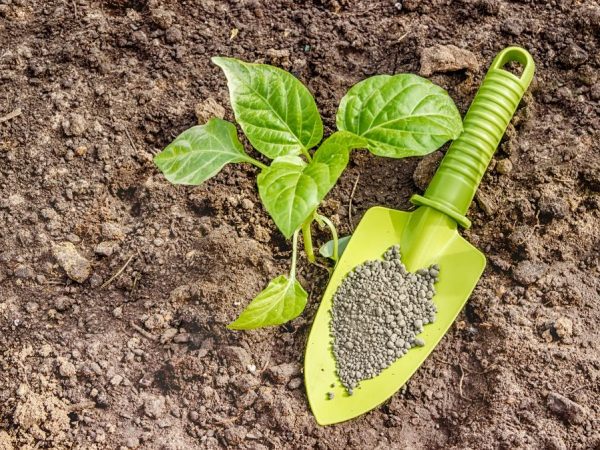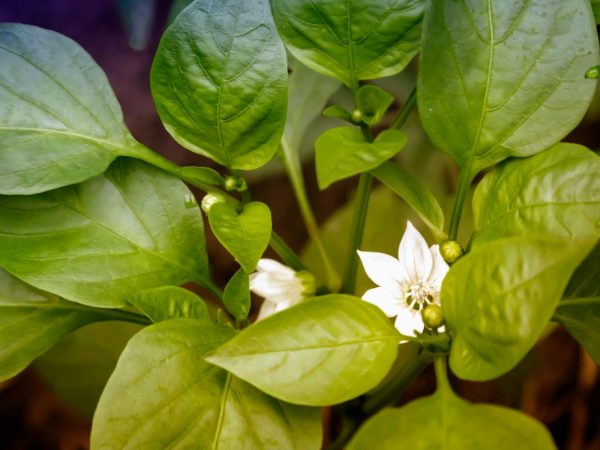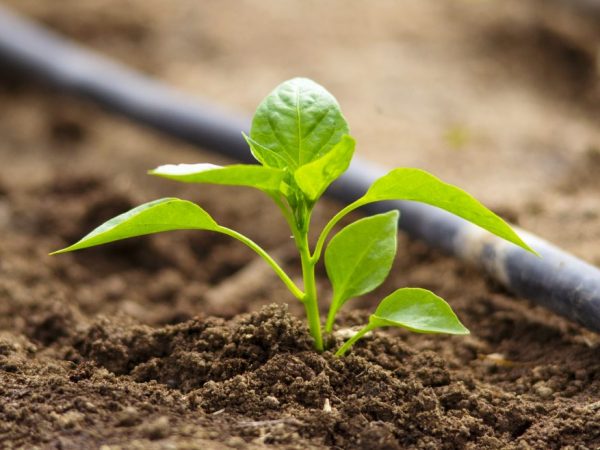Top dressing of peppers after planting in open ground
Pepper seedlings are necessarily planted in soft and mineral-rich soil, but after 10 days the fertile soil is noticeably depleted, because the bushes absorb all its strength. In order for the plants to continue to develop correctly and stably, it is necessary to feed the pepper after planting.

Top dressing of peppers after planting in open ground
In what cases top dressing is applied
Top dressing of pepper after planting should be carried out in a timely manner and with strict dosage of fertilizers. Both the lack of minerals and their excess lead to negative consequences.
The choice of mineral fertilizers depends on the needs of the plants. It is easy to determine which of the microelements is in the soil in insufficient quantities. To do this, you need to carefully consider the seedlings on the site.
- If the upper leaves are covered with reddish veins, and the lower ones become lethargic and yellow, the plant lacks phosphorus.
- If a lot of dry leaves appear on the bushes, curling up into tubes and falling off, potash fertilizers are applied to the soil. Also, an indicator of the lack of this microelement is the distillation of small and very light shoots in place of fallen leaves.
- The thin and gray leaves on the seedlings indicate that the plant needs to be fed with nitrogen fertilizers. The lack of this substance also leads to the fact that the seedlings cannot develop a sufficient root system.
You should not apply mineral fertilizers unnecessarily: this is how powerful bushes are formed with luxurious foliage, but with a complete absence of ovary. This is due to excess nitrogen.
Fertilization at different periods
Regardless of the place where the seedlings are grown, it should be remembered that fertilization of the soil with various types of minerals must be alternated. Some gardeners prefer to use complex formulations.
You need to feed the seedlings several times per season. The application of any fertilizers after planting of plants is carried out only after they have taken root, and all subsequent ones - as needed.
Vegetation
After planting, pepper should be fed after 10-14 days. The time depends on the appearance of the plants. Unrooted seedlings should not be fertilized, since their weak root system perishes from an excess of substances. Then, instead of the expected benefit, the plants will be irreparably damaged.
The main fertilizer during the formation of the bush is urea and sodium humate. Nutrient fluid is prepared from:
- 10 liters of water;
- 25 ml of liquid humate or 2 tbsp. l. powder;
- 5 tsp urea.
The latter of these substances dissolve for a long time, so they should be poured with a small amount of water and left for about overnight.
Flowering and fruiting
Particular attention is paid to feeding seedlings during the period of fruiting and ovary formation. To attract bees, plants are treated with the following composition:
- 10 liters of cold water;
- 20 g boric acid;
- 1 kg of granulated sugar.

Be sure to feed the plants during the fruit set.
The loose components are dissolved in water, and the resulting liquid is applied from a spray bottle under the root of the plant and on its trunk. Do not be afraid that pests will gather on the pepper: boric acid will scare them away. This substance also acts as a growth activator, because boron is not found in all complex fertilizers.
During the period of active fruiting, plants must be watered with organic fertilizers. An infusion of bird droppings or cow dung is effective.
Nutrient mass is prepared from 1 kg of organic matter and 10 liters of water. The infusion time of the mixture is 48 hours. After this time, top dressing is carried out. To do this, 1 liter of the infusion is dissolved in 10 liters of pure non-chlorinated water and the seedlings are watered with this liquid at the rate of 500 ml for each bush. After fertilization, the garden bed is watered abundantly.
If growth has slowed down
It happens that plants need fertilization at the moment when the first ovary is formed. Sometimes it happens that with favorable external signs of the buds, the ovary falls off, and the plants themselves slow down growth. In such situations, nitrogen fertilizers should be used. These substances are applied every 10 days until the formation of the first ovaries.
As soon as the plants form fruit, gardeners often notice a stop in growth and the absence of new shoots. To avoid this and preserve the pods, complex mineral fertilizers with phosphorus are introduced into the soil. This element also helps to resist the drying out of the crown. The frequency of application of multicomplex fertilizer is not limited, and the frequency is 14 days.
Differences in feeding
Top dressing of greenhouse peppers and plants in the open field has a number of fundamental differences. They relate to a greater extent to the frequency and multiplicity of the introduction of minerals and organic matter. Nutrient mixtures for plants in greenhouses do not differ in composition from substances used in ordinary beds.
In the greenhouse
The soil in the greenhouse is fertilized with a nitrogen substance before planting the peppers in a permanent place. The best option is compost or well-rotted cow dung. The application rate of the substance is 10 kg per 1 sq. m. If nightshades used to grow on the site, potash should be added along with nitrogen fertilizers.
- After the seedlings are accepted, they must be fertilized. Usually, the first time this is done 2 weeks after disembarkation. After fertilizing, be sure to water the site, and the next day they loosen it, providing air access to the roots.
- You can feed the peppers a second time after planting in the ground about a month after the first fertilization. Usually, during this period, plants actively throw out buds; in some early varieties and hybrids, the first ovary is even visible.
- The third time to feed the pepper after planting the seedlings should be at the time of fruit formation. At the choice of the gardener, processing can be both root and foliar. There are also no uniform recommendations for the use of this or that fertilizer. You need to choose nutrient mixtures, depending on the needs of the plant.
In the open field

The soil for planting will be prepared in advance
In the open field, peppers receive more minerals, because rainwater gets on them. At the same time, natural watering can harm plants, because often the sun comes out immediately after the rain, and the leaves of the peppers get burned. Only plants with developed foliage can withstand external influences. To do this, there must be enough potassium in the soil.
- The seedling beds are prepared at least 2 weeks before planting. The best fertilizer for this is potash-phosphorus mixtures. They are brought in at the rate of 50 g per 1 sq. m. Plants caught in fertile soil will receive the first dose of nutrients.
- The second feeding of pepper after planting seedlings in open ground is carried out no earlier than 2 weeks after the first. During this time, the plants will grow a lot, but have not yet formed flowers.
- The third time the seedlings are fertilized during the budding period. All subsequent applications of mineral fertilizers are carried out as needed.
Mineral fertilizers
Top dressing of peppers enhances plant growth and is used to prevent a number of diseases:
- To prevent root rot, dry wood ash is introduced under the pepper bushes at the rate of 1 kg per 5 sq. m.
- Dry black tea leaves are used for pest control and mulch. As a growth enhancer for the ovary, it is recommended to dissolve 300 ml of strong tea leaves in 10 liters of cold water, and then spray the plants with this solution. It is advisable to feed the seedlings in the evening or at any time of the day in cloudy weather.
- To combat apical rot, it is recommended to use a 0.2% solution of calcium nitrate. The nutrient is added at the rate of 500 ml for each bush.
Conclusion
Correct and timely application of fertilizers to the soil helps plants to form healthy bushes, as well as to set the maximum number of fruits. Strong seedlings are disease resistant and can resist pests. Fertilized plants always give a rich harvest, and their fruits are necessarily massive and thick-walled.


